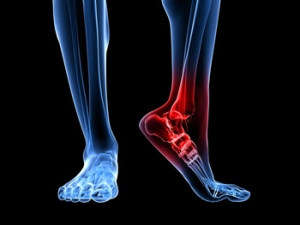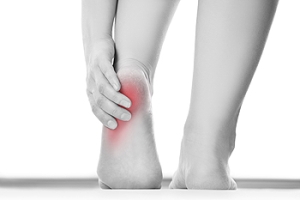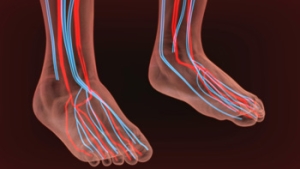
Shoes and Pregnancy
 There are numerous women who are pregnant and that feel pressured to wear fashionable high heels despite the damage that may occur to their feet. Strain may be inflicted on the joints of the feet, and may affect the style of walking. Additionally, many pregnant women choose to wear flip flops, and research has indicated that this may lead to painful heels and arches. During pregnancy, the body undergoes major changes, which can include the muscles and ligaments becoming softer, and this is often a result of an increase in specific hormones. If you are pregnant, and have questions about what type of shoes to wear during this time, please consult with a podiatrist.
There are numerous women who are pregnant and that feel pressured to wear fashionable high heels despite the damage that may occur to their feet. Strain may be inflicted on the joints of the feet, and may affect the style of walking. Additionally, many pregnant women choose to wear flip flops, and research has indicated that this may lead to painful heels and arches. During pregnancy, the body undergoes major changes, which can include the muscles and ligaments becoming softer, and this is often a result of an increase in specific hormones. If you are pregnant, and have questions about what type of shoes to wear during this time, please consult with a podiatrist.
Pregnant women with swollen feet can be treated with a variety of different methods that are readily available. For more information about other cures for swollen feet during pregnancy, consult with Dr. Michael A. Wood from Foot Health Institute. Our doctor will attend to all of your foot and ankle needs.
What Foot Problems Can Arise During Pregnancy?
One problem that can occur is overpronation, which occurs when the arch of the foot flattens and tends to roll inward. This can cause pain and discomfort in your heels while you’re walking or even just standing up, trying to support your baby.
Another problem is edema, or swelling in the extremities. This often affects the feet during pregnancy but tends to occur in the later stages.
How Can I Keep My Feet Healthy During Pregnancy?
- Wearing orthotics can provide extra support for the feet and help distribute weight evenly
- Minimize the amount of time spent walking barefoot
- Wear shoes with good arch support
- Wear shoes that allow for good circulation to the feet
- Elevate feet if you experience swelling
- Massage your feet
- Get regular, light exercise, such as walking, to promote blood circulation to the feet
If you have any questions please feel free to contact one of our offices located in Lansing, and Chicago, IL . We offer the newest diagnostic and treatment technologies for all your foot and ankle needs.
Pregnancy and Foot Health
Many pregnant women complain about foot pain while they are expecting. Foot pain can primarily be caused by weight gain and hormonal changes taking place in the body. By understanding how pregnancy impacts the health of a woman's feet, a pregnant woman can take action to keep her feet as healthy and comfortable as possible.
Because a woman's weight changes during pregnancy, more pressure is brought to bear on both the legs and the feet. This weight shift can cause two major foot problems: over-pronation, also known as flat feet, as well as edema, which is swelling of the feet. Over-pronation occurs when the arch of the foot flattens, causing the foot to roll inwards when the individual is walking, and can aggravate the plantar fascia tissues located along the bottom of the feet. If these tissues become inflamed, a pregnant woman can experience pain in the heel of the foot as well as severe foot pain while walking or standing. Swelling of the feet, or edema, often occurs in the later stages of pregnancy. It is caused by slow circulation and water retention, and may turn the feet a light purple color.
To keep feet in good health and prevent over-pronation, pregnant women should avoid walking barefoot and be sure they are wearing shoes that offer good arch support. A device known as an orthotic can be added to regular footwear in order to provide additional support for the feet during pregnancy. Any expectant mother whose feet hurt should first check to see if the shoes she is wearing are old, worn out and not offering the proper support necessary for distributing the weight of her body during pregnancy.
To treat edema of the feet, a good start is to wear quality footwear which offers support and good circulation. Keep feet elevated whenever possible by using a foot stool while seated. Stay well hydrated by drinking plenty of water to prevent water retention in the feet. Any swelling that occurs in only one foot should be examined as soon as possible by a doctor.
Good foot health during pregnancy can help expectant mothers avoid foot pain that leads to other health problems. Massaging the feet and doing regular gentle exercise like walking aids foot health by contributing to good circulation. Supportive shoes are also a good investment that will support foot health during pregnancy.
Sever’s Disease: Not as Scary as It Sounds
 If your child complains of foot pain and you take them to the podiatrist, hearing that they have been diagnosed with Sever’s disease can be frightening. Fortunately, Sever’s disease, or calcaneal apophysitis as it is sometimes called, sounds a lot worse than it really is. Rather than being an actual disease, Sever’s disease is an overuse injury. Simply put, it is an injury to the growth plate of the heel bone. Children’s heel bones are typically not done developing until the age of 14. As your child grows, new bone is forming in the heel’s growth plate, a weak area located at the back of the heel. Repetitive stress on this growth plate from participating in sports and activities that involve running and pounding on a hard surface, can cause inflammation and muscle strain. Your child may complain of pain in the back or bottom of the foot, fatigue, or pain while walking or doing sports. With the professional treatment, your child will soon be back on their feet. If you suspect that your child may have Sever’s disease, please visit a podiatrist for a proper diagnosis and treatment.
If your child complains of foot pain and you take them to the podiatrist, hearing that they have been diagnosed with Sever’s disease can be frightening. Fortunately, Sever’s disease, or calcaneal apophysitis as it is sometimes called, sounds a lot worse than it really is. Rather than being an actual disease, Sever’s disease is an overuse injury. Simply put, it is an injury to the growth plate of the heel bone. Children’s heel bones are typically not done developing until the age of 14. As your child grows, new bone is forming in the heel’s growth plate, a weak area located at the back of the heel. Repetitive stress on this growth plate from participating in sports and activities that involve running and pounding on a hard surface, can cause inflammation and muscle strain. Your child may complain of pain in the back or bottom of the foot, fatigue, or pain while walking or doing sports. With the professional treatment, your child will soon be back on their feet. If you suspect that your child may have Sever’s disease, please visit a podiatrist for a proper diagnosis and treatment.
Sever's disease often occurs in children and teens. If your child is experiencing foot or ankle pain, see Dr. Michael A. Wood from Foot Health Institute. Our doctor can treat your child’s foot and ankle needs.
Sever’s Disease
Sever’s disease is also known as calcaneal apophysitis, which is a medical condition that causes heel pain I none or both feet. The disease is known to affect children between the ages of 8 and 14.
Sever’s disease occurs when part of the child’s heel known as the growth plate (calcaneal epiphysis) is attached to the Achilles tendon. This area can suffer injury when the muscles and tendons of the growing foot do not keep pace with bone growth. Therefore, the constant pain which one experiences at the back of the heel will make the child unable to put any weight on the heel. The child is then forced to walk on their toes.
Symptoms
Acute pain – Pain associated with Sever’s disease is usually felt in the heel when the child engages in physical activity such as walking, jumping and or running.
Highly active – Children who are very active are among the most susceptible in experiencing Sever’s disease, because of the stress and tension placed on their feet.
If you have any questions, please feel free to contact one of our offices located in Lansing, and Chicago, IL . We offer the newest diagnostic and treatment technologies for all your foot and ankle injuries.
Sever's Disease
Sever’s disease, also known as calcaneal apophysitis is a common bone disorder that occurs during childhood. The disease is defined as an inflammation of the growth plate in the heel. When a child has a growth spurt, his heel bone grows faster than the muscles, tendons, and ligaments in his leg. This disease is a result of overuse. The people who are most likely to be affected by this disease are children who are in a growth spurt, especially boys who are from the ages of 5 to 13 years old. 60% of children with Sever’s disease have both heels involved.
Symptoms of this disease are heel pain that intensifies during running and jumping activities. The pain is typically localized to the posterior part of the heel. Symptoms may be severe, and they can easily interfere with daily activities. Children who play soccer, baseball, and basketball are more likely to develop Sever’s disease.
Your doctor will diagnose your child based on his or her symptoms, x-rays are generally not helpful in diagnosing this disease. Your doctor may examine both heels and ask your child questions about his or her activity level in sports. Your doctor may then use the squeeze test on your child’s heel to see if there is any pain. Nevertheless, some doctors might still use x-rays to rule out any other issues such as fractures, infections, and tumors.
Sever’s disease can be prevented by maintaining good flexibility while your child is growing. Another prevention method is to wear good-quality shoes that have firm support and a shock-absorbent sole. Sever’s disease can be treated by ceasing any activity that causes heel pain. You should apply ice to the injured heel for 20 minutes 3 times a day. Additionally, orthotics should be used for children who have high arches, flat feet, or bowed legs.
If you suspect your child has Sever’s disease, you should make an appointment with your podiatrist to have his or her foot examined. Your doctor may recommend nonsteroidal anti-inflammatory drugs (NSAIDs), such as ibuprofen or naproxen to relieve pain. In more severe cases, your child may need a cast to rest his or her heel. Fortunately, Sever’s disease does not cause long-term foot problems. After treatment, your child should start to feel better within two weeks to two months.
Types of Ankle Sprains
 Many people who participate in sporting activities that involve running and jumping may experience ankle sprains. A low ankle sprain occurs on the outside of the ankle, and is considered to be a common type of sprain. When the affected ligaments are above the ankle, it is categorized as a high ankle sprain. Common symptoms in both types of sprains include severe pain and discomfort, and it is often difficult to walk. Effective treatment for mild sprains include resting and elevating the affected foot, and this may be helpful in reducing existing swelling. Sprains that are moderate may require the patient to wear a boot, which can be beneficial in stabilizing the ankle as the healing process occurs. Severe sprains may require the patient to undergo physical therapy. If you have endured an ankle sprain, please speak to a podiatrist who can determine what the best treatment is for you.
Many people who participate in sporting activities that involve running and jumping may experience ankle sprains. A low ankle sprain occurs on the outside of the ankle, and is considered to be a common type of sprain. When the affected ligaments are above the ankle, it is categorized as a high ankle sprain. Common symptoms in both types of sprains include severe pain and discomfort, and it is often difficult to walk. Effective treatment for mild sprains include resting and elevating the affected foot, and this may be helpful in reducing existing swelling. Sprains that are moderate may require the patient to wear a boot, which can be beneficial in stabilizing the ankle as the healing process occurs. Severe sprains may require the patient to undergo physical therapy. If you have endured an ankle sprain, please speak to a podiatrist who can determine what the best treatment is for you.
Although ankle sprains are common, they aren’t always minor injuries. If you need your ankle injury looked at, contact Dr. Michael A. Wood from Foot Health Institute. Our doctor can provide the care you need to keep you pain-free and on your feet.
How Does an Ankle Sprain Occur?
Ankle sprains are the result of a tear in the ligaments within the ankle. These injuries may happen when you make a rapid shifting movement while your foot is planted. A less common way to sprain your ankle is when your ankle rolls inward while your foot turns outward.
What Are the Symptoms?
- Pain at the sight of the tear
- Bruising/Swelling
- Ankle area is tender to touch
- In severe cases, may hear/feel something tear
- Skin discoloration
Preventing a Sprain
- Wearing appropriate shoes for the occasion
- Stretching before exercises and sports
- Knowing your limits
Treatment of a Sprain
In many cases, the RICE method (Rest, Ice, Compression, and Elevate) is used to treat ankle sprains. However, you should see a podiatrist to see which treatment option would work best with your injury. In severe cases, surgery may be required.
It is important to ask your doctor about rehab options after you receive treatment for your injury. Stretching, strength training, and balance exercises may help the ankle heal while also preventing further injury.
If you have any questions, please feel free to contact one of our offices located in Lansing, and Chicago, IL . We offer the newest diagnostic and treatment technologies for all your foot care needs.
Ankle Sprains
Ankle sprains occur when ligaments that support the ankle stretch beyond their limits and tear. These types of injuries are very common and can occur in people of all ages. Sprains may range from mild to severe, depending on how much damage is done to the ligaments. If a sprain goes untreated, a more severe sprain may occur which can further damage the ankle. Repeated ankle sprains can lead to chronic ankle pain.
There are some risk factors that can increase your risk of suffering a sprained ankle. Those who participate in sports, walk on uneven surfaces, have a prior ankle injury, are in poor physical condition, or wear improper shoes are more likely to get a sprained ankle.
There are a few symptoms to look out for if you suspect you are suffering from a sprained ankle. Some common symptoms are swelling, bruising, tenderness, and instability of the ankle. In cases where the tearing of the ligaments is severe, there may be a “popping” sound when the strain occurs.
The RICE method is proven to be effective in treating ankle sprains. RICE stands for Rest, Ice, Compression, and Elevation. Rest is important for treatment, especially within the first 24 to 48 hours. You should also ice your sprained ankle for the first 48 hours for 20 minutes at a time. A small piece of cloth should be placed between the ice and the affected area. For the compression step, you should wear a brace that is snug, but not too tight that it cuts off circulation. When choosing a brace, be sure to choose one that is suitable for the type of ankle sprain you have. Lastly, you should elevate your foot above the heart as often as possible.
After you treat a sprain, you should go through rehabilitation to prevent the injury from occurring again. There are three phases to the rehab process. The first phase involves resting, protecting, and reducing the swelling of the injury. The second phase consists of restoring the ankle’s flexibility, range of motion, and strength. The third phase consists of slowly returning to activity and maintenance exercises.
If you suspect you have an ankle sprain, you shouldn’t hesitate to consult with your podiatrist. Your podiatrist will be able to give you a proper diagnosis and a suitable treatment option for your condition.
Exercises for Heel Spur Pain
 Heel spurs are bony growths on the bottom of the heel bone. Though they are usually painless, they can cause or worsen the pain of other foot conditions such as plantar fasciitis or Achilles tendonitis. There are several exercises you can do to prevent or reduce the pain of a heel spur. You may try an exercise called Heel Ups, where you place a tennis ball between the heels and hold the ball in place by squeezing the heels together. You then rise up on your toes and come back down several times while keeping the ball in place. Another exercise that you can do is a Soleus Stretch, where you stand facing a wall and place your foot up against it, bend your knee, and lean forward until you feel a stretch in your calf. For more information about heel spurs, speak with a podiatrist today.
Heel spurs are bony growths on the bottom of the heel bone. Though they are usually painless, they can cause or worsen the pain of other foot conditions such as plantar fasciitis or Achilles tendonitis. There are several exercises you can do to prevent or reduce the pain of a heel spur. You may try an exercise called Heel Ups, where you place a tennis ball between the heels and hold the ball in place by squeezing the heels together. You then rise up on your toes and come back down several times while keeping the ball in place. Another exercise that you can do is a Soleus Stretch, where you stand facing a wall and place your foot up against it, bend your knee, and lean forward until you feel a stretch in your calf. For more information about heel spurs, speak with a podiatrist today.
Heel spurs can be incredibly painful and sometimes may make you unable to participate in physical activities. To get medical care for your heel spurs, contact Dr. Michael A. Wood from Foot Health Institute. Our doctor will do everything possible to treat your condition.
Heels Spurs
Heel spurs are formed by calcium deposits on the back of the foot where the heel is. This can also be caused by small fragments of bone breaking off one section of the foot, attaching onto the back of the foot. Heel spurs can also be bone growth on the back of the foot and may grow in the direction of the arch of the foot.
Older individuals usually suffer from heel spurs and pain sometimes intensifies with age. One of the main condition's spurs are related to is plantar fasciitis.
Pain
The pain associated with spurs is often because of weight placed on the feet. When someone is walking, their entire weight is concentrated on the feet. Bone spurs then have the tendency to affect other bones and tissues around the foot. As the pain continues, the feet will become tender and sensitive over time.
Treatments
There are many ways to treat heel spurs. If one is suffering from heel spurs in conjunction with pain, there are several methods for healing. Medication, surgery, and herbal care are some options.
If you have any questions feel free to contact one of our offices located in Lansing, and Chicago, IL . We offer the latest in diagnostic and treatment technology to meet your needs.
How to Treat Heel Spurs
Heel spurs are calcium deposits that cause bone protrusions on the heel bone. Heel spurs are usually associated with plantar fasciitis, which occurs when the plantar fasciitis in the foot becomes inflamed. Typically, heel spurs don’t cause any symptoms. However, they can produce chronic or intermittent heel pain. Those who have had the condition often describe the irritation as a stabbing pain.
There are risk factors that may make you more likely to develop heel spurs. People who have abnormal walking gaits, run and jog on hard surfaces, are obese, or wear poorly fitting shoes are more likely to develop heel spurs.
Fortunately, there are precautions you can take to avoid developing heel spurs. One of the best ways to do this is by wearing well-fitting shoes with shock-absorbent soles. Another preventative technique is to choose running shoes if you plan on running, and walking shoes if you plan on walking. Shoes are made for different activities and it is important to research a shoe before you purchase a pair.
The pain associated with heel spurs often decreases the more you walk. However, a recurrence of pain after an extended period of rest or walking is likely to occur with this condition. Those with severe heel spur pain may opt to go the surgical route for treatment. However, more than 90% of those with the condition get better without surgical treatment. If you have a heel spur and want to know if surgery is right for you, you should go to your podiatrist and he or she will be able to conduct a pre-surgical test or exam to determine if you are an optimal candidate for surgery.
The Risks of Peripheral Artery Disease
 Peripheral artery disease (PAD) is a medical condition in which the blood vessels in your lower limbs narrow or become clogged due to the buildup of arterial plaque. This reduction in blood flow means that you have poor circulation, which increases your risk of developing a whole host of potentially serious medical complications, including strokes, heart attacks, and aneurysms. Left undiagnosed and untreated, PAD in your lower limbs can advance to the point where there is limited to no blood flow, resulting in the death of the muscles in your lower limbs and increasing your risk of needing a limb amputation. Fortunately, PAD is easy to screen for and can usually be managed with lifestyle changes and medication, especially if it is detected in its earliest stages. Symptoms of PAD in the lower limbs include pain or cramping while walking, swelling, numbness, skin discoloration, and poorly healing sores. If you experience any of these symptoms, it is strongly recommended that you consult with a podiatrist who can screen for PAD and provide you with treatment options.
Peripheral artery disease (PAD) is a medical condition in which the blood vessels in your lower limbs narrow or become clogged due to the buildup of arterial plaque. This reduction in blood flow means that you have poor circulation, which increases your risk of developing a whole host of potentially serious medical complications, including strokes, heart attacks, and aneurysms. Left undiagnosed and untreated, PAD in your lower limbs can advance to the point where there is limited to no blood flow, resulting in the death of the muscles in your lower limbs and increasing your risk of needing a limb amputation. Fortunately, PAD is easy to screen for and can usually be managed with lifestyle changes and medication, especially if it is detected in its earliest stages. Symptoms of PAD in the lower limbs include pain or cramping while walking, swelling, numbness, skin discoloration, and poorly healing sores. If you experience any of these symptoms, it is strongly recommended that you consult with a podiatrist who can screen for PAD and provide you with treatment options.
Peripheral artery disease can pose a serious risk to your health. It can increase the risk of stroke and heart attack. If you have symptoms of peripheral artery disease, consult with Dr. Michael A. Wood from Foot Health Institute. Our doctor will assess your condition and provide you with quality foot and ankle treatment.
Peripheral artery disease (PAD) is when arteries are constricted due to plaque (fatty deposits) build-up. This results in less blood flow to the legs and other extremities. The main cause of PAD is atherosclerosis, in which plaque builds up in the arteries.
Symptoms
Symptoms of PAD include:
- Claudication (leg pain from walking)
- Numbness in legs
- Decrease in growth of leg hair and toenails
- Paleness of the skin
- Erectile dysfunction
- Sores and wounds on legs and feet that won’t heal
- Coldness in one leg
It is important to note that a majority of individuals never show any symptoms of PAD.
Diagnosis
While PAD occurs in the legs and arteries, Podiatrists can diagnose PAD. Podiatrists utilize a test called an ankle-brachial index (ABI). An ABI test compares blood pressure in your arm to you ankle to see if any abnormality occurs. Ultrasound and imaging devices may also be used.
Treatment
Fortunately, lifestyle changes such as maintaining a healthy diet, exercising, managing cholesterol and blood sugar levels, and quitting smoking, can all treat PAD. Medications that prevent clots from occurring can be prescribed. Finally, in some cases, surgery may be recommended.
If you have any questions, please feel free to contact one of our offices located in Lansing, and Chicago, IL . We offer the newest diagnostic and treatment technologies for all your foot care needs.







